
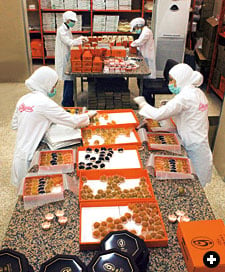 |
| Packers box chocolates and candied fruit for distribution among Ghraoui’s 16 retail outlets in locations from downtown Damascus to Kuwait, Jordan and Dubai. |
Written by Alia Yunis
Photographed by Tor Eigeland

 ur fans include former French prime minister Jacques Chirac, Diane Sawyer and members of the Kuwaiti parliament,” Ghraoui says. “We even have a Swiss cabinet minister who orders our chocolates. And Ghraoui chocolate was selected as the best product among 150 participating companies from Syria, Lebanon and Jordan by the Japanese External Trade Organization in 2003.”
ur fans include former French prime minister Jacques Chirac, Diane Sawyer and members of the Kuwaiti parliament,” Ghraoui says. “We even have a Swiss cabinet minister who orders our chocolates. And Ghraoui chocolate was selected as the best product among 150 participating companies from Syria, Lebanon and Jordan by the Japanese External Trade Organization in 2003.”
“Mr. Ghraoui was one of the first in the Middle East to present a complete range of chocolate and fruit confections of an excellent caliber, and he was able to bring them to Europe with great success,” says Sylvie Douce, the producer of the Salon du Chocolat competition. “With remarkable quality, he has created a unique alliance of fruits, nuts and chocolate.”
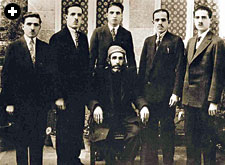 |
| Courtesy of Bassam Ghraoui |
| Damascus chocolate pioneer Sadek Ghraoui stands second from left in a family photo taken in the 1920’s. Below: His son Bassam today oversees production and distribution of more than 100 types of confectionery, most of which use chocolate. |
 |
History may be on Ghraoui’s side as he pursues making his family name internationally synonymous with chocolate. Damascus is already known for sweets throughout the Middle East, going back to the heyday of the Silk Roads, when the city was a major trading entrepôt, welcoming caravans of up to 3000 camels. The caravans would stop to rest and replenish their supplies, including sweets and dried fruits that could last the remainder of the journey.
In addition, Ghraoui himself is the son of the first person to showcase Syria’s sweets in the West at international expositions. In fact, he is the fifth generation to head the Ghraoui Group, one of Damascus’s oldest trading and merchant companies. He is a tall, elegant and polished businessman—trained as a civil engineer—whose office is meticulously decorated with family photos and awards and whose bookshelves are filled with history texts and biographies of leaders such as Napoleon and Colin Powell. But at his state-of-the-art production center in Ghorta, a small agricultural town just outside Damascus, Ghraoui’s tailored suit is covered by one of the white factory smocks and an almost manic enthusiasm overtakes him. He becomes the kid in the candy store—only he owns this candy store. “This is a symphony of flavors,” he beams as he shows you around the pristine center, energetically navigating around three-meter (9') vats of swirling dark, milk and white chocolate. “And what makes our chocolate unique—beyond its quality—is that our creations reflect Syria. See, try this: Damascus almonds, brought just two days ago from the farmlands where they were grown.”
He pops the dark chocolate–covered almond into your hand. As you are savoring its crispness and sweetness, his frenetic energy rolls on. “Here, take this one,” he says, handing you a heart-shaped chocolate filled with hazelnut praline ganache. “It’s the one Diane Sawyer fell in love with last year, when she came to Damascus to interview President al-Assad.” He keeps on handing out samples as he pauses to say hello to workers coating little balls of fresh pistachio paste in dark chocolate, women shelling hazelnuts, other employees carefully covering such Arab confections as manne wa selwa (a chewy pistachio-filled sweet flavored with mastic and cardamom) in milk chocolate, and still others dipping plump dried Damascus apricots and candied orange peels in dark chocolate. Syria—and Ghraoui in particular—has long been known for its dried fruits, but Ghraoui has minimized that product line in recent years, literally folding the dried-fruit business into his chocolate.
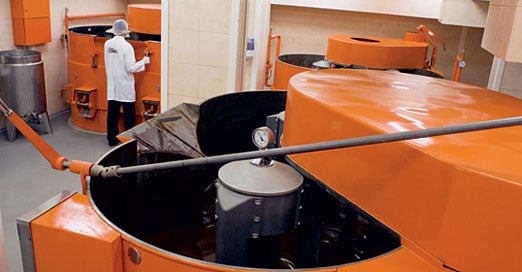 |
| Conching machines knead and mix chocolate to reduce its acidity and improve its flavor and mouthfeel. |
On the second floor of the factory, young women use tiny brushes to paint intricate holiday designs on chocolates, which are then boxed up with elaborate ribbons and bows, destined for a party at the American Embassy. Innovative box designs that become a topic of conversation in themselves are a big part of the package when it comes to the appreciation of chocolate in the Middle East.
 |
| Workers painstakingly crack and clean walnuts. Below: For centuries, Damascus was renowned for its dried and candied fruits as well as its confectionery, and fruits remain a Ghraoui specialty—though they are often filled or coated with chocolate. At the Ghorta factory, workers prepare apricots to be filled with pistachios; some will then be dipped in chocolate. |
 |
“We make about 50 varieties on any given day, but we have 120 varieties in total,” says general manager Mouhab al-Khani, who trains all of the 250 workers here for three months before they are allowed to make chocolates on their own. “We’re always developing new combinations.”
Al-Khani has worked for the Ghraoui firm for 15 years, something that gives Ghraoui almost as much pride as the chocolates themselves. “We have one employee who is the third generation of his family to work here,” he boasts. Then he stops at a table where an elderly man sits quietly shelling local walnuts. “And this is my favorite, Bilal. How long have you been working with the family?”
“Since 1948,” Bilal shrugs. “I’m retired, but I don’t know what else to do, so I still come and work a couple of hours a day.” Bilal once ran operations for Bassam Ghraoui’s father, the original founder of Ghraoui Chocolate.
“I have the weight of history on me,” Ghraoui explains, adding that he doesn’t need to make chocolate to live. “This is a passion. I wanted to honor my father’s memory, and rebuild and expand on his dream.”
The story of Ghraoui Chocolate is also the story of modern Syria. Back in his office, Ghraoui pulls out a family album that recounts the life of his father, Sadek. A distinguished businessman whose friends included future Syrian leaders and luminaries, Sadek Ghraoui began exhibiting Syrian crafts and products, particularly jams and dried-fruit confections, at world fairs in the 1920’s, winning several international medals for his participation. In 1930, Sadek was one of the founders of Compagnie Nationale des Conserves, which was Syria’s first fruit- and vegetable-canning company, with more than 1000 employees. The company’s products became widely known through Sadek’s participation in the fairs, and the fairs and expos in turn led to his discovery of chocolate. After visiting a chocolate factory in Paris, Sadek decided to make chocolates in Damascus, importing the chocolate in bulk from famed producers in France and England. But it wasn’t an easy sell.
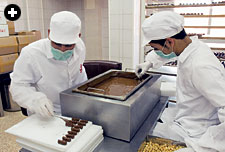 |
| Trios of hazelnuts are hand-dipped in chocolate. Below: Chocolate-covered marzipan bites are each topped with a walnut. |
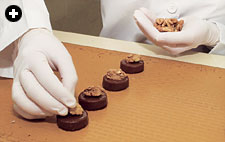 |
Arabs, mostly unfamiliar with chocolate, looked at the new confection with suspicion. “My father couldn’t get people to try it,” Ghraoui says. “So he began offering the chocolates in nice wooden boxes imported from Austria; each one came with a sterling silver knife on top, and that got people interested.”
Dr. Kassem Twair, a renowned historian and the former director of the Directorate General of Antiquities and Museums of Syria, is also the son of one of Syria’s first chocolate and candy traders. His father bought chocolates from many different producers, but he remembers that, when customers asked for the best, his father sold them Ghraoui chocolates. “The Arab world didn’t have much experience with chocolate until after World War I. The Germans first brought it to the area when they were working with the Ottomans, and then under British and French colonization it became more common,” Twair explains, adding that chocolate production in the region, in Lebanon specifically, only began after World War II. “From 1945 to 1949, my father used to get a lot of his products from Beirut. With the economic separation of Lebanon and Syria, many Syrians who had worked in the industry in Beirut came back and opened their own factories in Damascus.  But Ghraoui was still the Syrian name that meant quality. If customers wanted a lesser quality, my father offered them another brand.”
But Ghraoui was still the Syrian name that meant quality. If customers wanted a lesser quality, my father offered them another brand.”
In the firm’s heyday in the 1950’s, Ghraoui products were sold at Fauchon and Hediard in Paris and in London at Selfridges, Harrods, Fortnum & Mason and Army & Navy Stores—the latter earning them a royal warrant.
 |
| Under a manager’s eye, fruits are split and laid out on trays. Below: Whole pears are poached in sweet syrup. For centuries before refrigeration, sugar—like salt —was used as a preservative. |
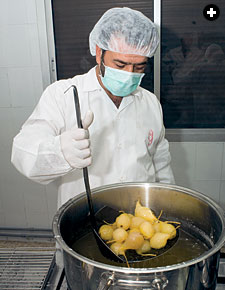 |
Then, in the 1960’s, Syrian nationalism curtailed production, limiting that luxury business to a small six-person shop for local consumption only. Sadek died when Bassam was 14 years old, but when Syria’s international trade opened up again in 1996, Bassam decided to “recapture his father’s chocolate dream” by building the Ghorta factory. Today, he has plans to expand the facility, now 4000 square meters (43,000 sq ft), by another 3000 square meters (32,300 sq ft) in the next couple of years.
In addition to outlets in Kuwait and Jordan—and several others planned for airports in Europe and the Gulf—Ghraoui today has five shops in Syria, including one at the Damascus airport. In all of them, sleek, polished chrome-and-glass counters are staffed by attractive young men and women in uniforms that are redesigned twice a year, much as the firm’s chocolate packaging—from wood boxes inlaid with mother-of-pearl mosaic to Christmas boxes in velvet and gold brocade—also changes with the seasons. Complex window displays are switched out every month. Every day, salespeople give out samples and calmly take orders, even on days when the holiday rush creates lines out the door and keeps the store open until two in the morning. At approximately 2000 Syrian pounds a kilo ($18/lb), the chocolates are the most expensive in the country, well over double the price charged at other elite chocolate shops in Damascus and nearly double the price at Ghraoui’s only significant competitor in the Middle East—and the only non-Syrian chocolate shop in the country —the Lebanese chain Patchi, particularly known for its intricate and festive boxes. Ghraoui’s prices don’t sit well with everyone. “I’m fine getting my chocolate from Slik,” says the owner of a boutique hotel popular with tourists, referring to a chocolate shop in an upscale area of Damascus. “Okay, be the best, but charging so much more is just not right.”
Ghraoui doesn’t worry about these comments. “Low price is not our goal,” he explains. “I know much of the
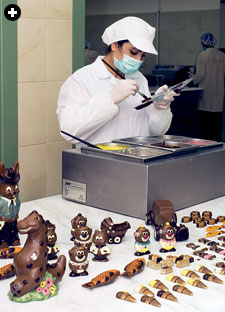 |
| Colored glazes, hand-painted inside a mold, will adhere to the chocolate poured into it, producing highly decorative specialty treats. |
local market doesn’t have a sophisticated palate when it comes to chocolate. If we catered only to the local market, we could not expand. Export is our survival. Now, 50 percent of the business is the export market, but I expect that to go to 80 percent in the next two years. This is a luxury product, and the quality is what is important.”
While chocolate may be relatively new in the 8000-year history of Damascus, its history as a luxury product goes back more than 3000 years. Archeologists in Honduras last year unearthed evidence of cacao’s use as an elite product as early as 1100 BC. “What we’re seeing in this early village in Honduras is a very early stage in which serving cacao at fancy occasions is one of the strategies that upwardly mobile families were using to establish themselves,” says John Henderson, an anthropologist at Cornell University. “It was originally a way to accumulate prestige.”
Bassam Ghraoui continues to view it that way. When he sees one of his chocolates melt rapidly in your hand, he is pleased in spite of the mess. “A low melting point is a sign of true quality chocolate,” he smiles. “I don’t substitute vegetable oils to make the chocolates last longer. That’s what they do in America, and now, sadly, some companies in Europe are beginning to find that acceptable as well. I don’t. I won’t.”
Sweet Success
Damascus is often called the sweets capital of the Arab world, and the competition among the city’s pastry and confectionery shops is fierce. Everyone —from taxi drivers to prominent businessmen and academics—has an opinion on where to go for the best: You must go to Semiramis; you should try Faisels; no place is like Zein Barakji. “How can I tell you which one is the best?” says one hotel receptionist.
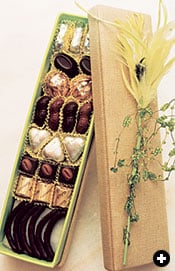 |
| Elegantly decorated gift boxes are a long-standing signature of Ghraoui, which hopes to soon expand its retail boutiques into Qatar, Saudi Arabia and Abu Dhabi. |
 |
“There are so many places that I could live here for the rest of my life and not try them all.”
Ma‘mul (nut-filled semolina cookies), baklava, sesame and pistachio candies enrobed in honey, and kunafa (a hot cheese pastry) are made throughout the Levant. “In Damascus so much is still made with real samna (ghee, or clarified butter), and they haven’t picked up the western habit of using chemicals in their food and produce,” theorizes a Jordanian cab driver, who shuttles passengers carrying kilos of sweets between Amman and Damascus every day. “That keeps the flavor rich.”
Syria’s Mediterranean climate is suitable for growing a great abundance and variety of fruits, and with its continued tradition of small family farms, Syrian agriculture is largely organic. That may help explain the robust flavor of its jams and dried fruits, which Damascus has turned into an art form. Whole baby pears, apples and even eggplants are miraculously dried down to delectable finger sweets without losing their plumpness, shape or taste.
“From the time of the Greeks and Romans, Damascus was a vital trading center between Asia and Europe,” says Twair. “Not only did that give Damascenes access to the best ingredients in the world, it also made theirs a service economy. A competitive one, too. You couldn’t just make sweets: You had to make better sweets than your neighbor. You had to have the best products, something that people could take with them as they continued their journey or enjoy while they stayed here. The frenetic energy of a trading city may be the reason sugar was so important. People needed the energy and warmth sweets provided.”
“Nature provided Damascus with the best quality ingredients for making sweets. The fruits and the nuts here are unbeatable,” says Bassam Ghraoui. But he also worries that Damascus is losing its culinary heritage. “There is a fast food invasion—there is a KFC here now! People are looking for quick things, and that hurts quality.”
“But Damascenes have just as much pride in their sweets as they used to,” his nephew and commercial director, Mohamed Midani, reassures him. Twair confirms Midani’s words when he says, “In Turkey they kill the flavor with too much sugar and in India with too much spice. We’re in the middle. You can eat a kilo of Syrian sweets because they are a mixture of sweet and spice perfected.
 |
Alia Yunis is a screenwriter and free-lancer whose work has appeared in the Los Angeles Times and other publications. She won a 2005 PEN Emerging Voices fellowship, and her first novel, The Night Counter, will be published by Shaye Areheart Books, a division of Random House. |
 |
Tor Eigeland (www.toreigeland.com) lives near Toulouse, France. He has photographed for Saudi Aramco World for more than 40 years, and Damascus remains “right at the top of my list of places to revisit.” |